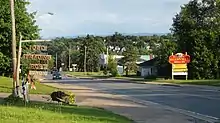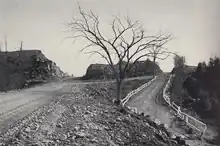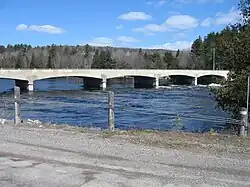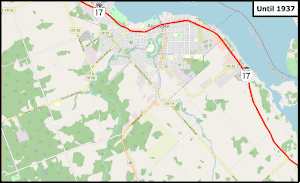Highway 41 | |||||||
|---|---|---|---|---|---|---|---|
| Route information | |||||||
| Maintained by the Ministry of Transportation of Ontario | |||||||
| Length | 159.6 km[1] (99.2 mi) | ||||||
| Existed | May 1, 1935[2]–present | ||||||
| Major junctions | |||||||
| South end | |||||||
| North end | |||||||
| Location | |||||||
| Country | Canada | ||||||
| Province | Ontario | ||||||
| Highway system | |||||||
| |||||||
| |||||||
King's Highway 41, commonly referred to as Highway 41, is a provincially maintained highway in the Canadian province of Ontario. The 159.6-kilometre (99.2 mi) highway travels in a predominantly north–south direction across eastern Ontario, from Highway 7 in Kaladar to Highway 148 in Pembroke. The majority of this distance crosses through a rugged forested region known as Mazinaw Country. However, the route enters the agricultural Ottawa Valley near Dacre. A significant portion of Highway 41 follows the historic Addington Colonization Road, built in 1854.
Highway 41 was first assumed in 1935, though ironically the initial route is no longer part of the highway. It was extended north to meet the eastern terminus of Highway 60 at Golden Lake in 1937. The following year, a southern discontinuous section of the highway was established north from Picton in Prince Edward County. A series of changes in 1957 extended Highway 60 east to Renfrew and Highway 41 north to Pembroke; this established a concurrency of the two highways through Eganville, which remains to this day.
At its greatest length, Highway 41 travelled from Highway 2 in Napanee north to Highway 17 and Highway 62 in Pembroke, a distance of 234.5 km (145.7 mi), including the discontinuous southern section. The Prince Edward County section was renumbered as Highway 49 in 1965 in anticipation of the building of the Quinte Skyway, while the original section, between Highway 2 and Highway 7, was transferred to Lennox and Addington County in 1998, and is now County Road 41.
Route description

Highway 41 is a 159.6 km (99.2 mi) highway that travels in a north–south direction from Highway 7 in Kaladar to Highway 148 in Pembroke. The majority of this distance crosses through a rugged forested region of Eastern Ontario known as Mazinaw Country. However, the route enters the Ottawa Valley at a point between Dacre and Eganville; north of there the land use surrounding the highway becomes partially agricultural.[3][4]
Traffic levels along Highway 41, in 2016, were highest near Pembroke, where approximately 5,300 vehicles travelled the road on an average day. Volumes are lowest through the Mazinaw Country portion of the route, between Bon Echo Provincial Park and Eganville, where less than 2,000, and as few as 1,300 vehicles, travel the highway on an average day.[1] With the exception of a few short passing lanes, the entire length of the highway is two lanes wide.[5]
Two locations along Highway 41 are maintained under a Connecting Link agreement between the Ministry of Transportation of Ontario (MTO) and the local municipality, in which funding for maintenance is split between the two. These Connecting Links are located through the towns of Eganville and Pembroke, and are 2.0 km (1.2 mi) and 4.0 km (2.5 mi) long, respectively.[6] The remainder of the highway is maintained solely by the MTO.[1]
Kaladar – Madawaska River

Highway 41 begins in the centre of Lennox and Addington County at Highway 7, in the village of Kaladar. The highway once continued south to Napanee, but this is now County Road 41.[3] It travels north, immediately ascending Kaladar Hill into a swamp-laden, heavily-forested region of the Canadian Shield, roughly following the Addington Colonization Road.[7] After passing through the village of Northbrook, the highway — and more accurately, the original Addington Road — straddle the boundary between Lennox and Addington County and Frontenac County, as well as the municipalities of Addington Highlands and North Frontenac. It passes through the community of Cloyne, then meets the southernmost point of Mazinaw Lake, of which it travels near or along the western shore.[3][4]
The highway enters Bon Echo Provincial Park, which sits near the midpoint of the lake. Within the park is Mazinaw Rock, a large 100-metre-high (330 ft) pictograph-laden granite rock escarpment, as well as a National Historic Site of Canada.[3][8] North of the park, Highway 41 — now entirely within Lennox and Addington County — continues alongside the northern half of Mazinaw Lake, and thereafter the Mississippi River, to the headwaters of the latter at Mackavoy Lake.[3][9] Passing through Ferguson Corners, it departs eastward from the Addington Colonization Road. At Vennachar Junction, it turns north, then encounters Highway 28 just east of the town of Denbigh. Meandering northeast from there, the highway roughly parallels Hydes Creek to its confluence with the Madawaska River before curving east into Renfrew County. It crosses the river on a multiple-span concrete rigid arch bridge just prior to entering the community of Griffith. This bridge also serves as the downstream end of Lower Madawaska River Provincial Park.[3][4]
Madawaska River – Pembroke

Beyond Griffith, Highway 41 travels through the municipality of Greater Madawaska. It winds in a generally northeast direction towards Dacre. West of that community, it descends into the Ottawa Valley and meets Highway 132. At that junction, drivers must turn to remain on Highway 41; Highway 132 continues through Dacre. The route proceeds north, now in the municipality of Bonnechere Valley, and shortly after passing Constant Lake, straightens towards Eganville. Farmland appears for the first time at the hamlet of Perrault.[3][4] An intersection with former Highway 512 marks the entrance to Eganville, as well as the beginning of the Connecting Link Agreement through the town. After crossing the Bonnechere River, it meets Highway 60, with both highways becoming concurrent northward; the Connecting Link ends at Hartwig Street.[1][6]
Approximately 3 km (1.9 mi) north of Eganville, Highway 41 departs from Highway 60 and travels eastward through a mixture a farmland and forests within the municipality of North Algona Wilberforce. It gradually wraps around the east side of Lake Doré, before curving northward. After crossing Snake Creek at the northeastern tip of the lake, the highway travels straight north through forests. It passes through several communities within a short distance, the most significant of which is Rankin. Near its northern end, the route zig-zags into the municipality of Laurentian Valley, then curves northeast to intersect Highway 17 on the outskirts of Pembroke.[3][4] Within the town, both Highway 41 and Highway 148 are maintained under a Connecting Link Agreement.[6] Highway 41 follows Paul Martin Drive, River Road, and McKay Street through Pembroke before ending just south of the Ottawa River. The intersection of McKay Street and Pembroke Street serves as the northern terminus of Highway 41, as well as the western terminus of Highway 148.[3][4]
History

Although it did not become a provincial highway until the 1930s, the route that Highway 41 follows is similar to several colonization roads established in the mid-1800s. These forest-bound "roads", built to encourage settlement deeper into the province, were infamously rough wagon trails during dry times, and impassable quagmires throughout the spring and fall. The Addington Road, which travelled north from the Clare River (approximately 15 km (9.3 mi) south of Kaladar) to the Opeongo Line, would go on to form the nucleus of Highway 41 as far north as Denbigh. A rough line for this road was surveyed by Robert Bell in 1847.[10] Construction as far north as the Madawaska River was carried out under the supervision of local surveyor Aylsworth B. Perry between 1854 and 1857.[11] However, until the construction of Highway 41, travel through the Addington Highlands and Opeongo Hills was slow and arduous.[12]
Provincial assumption
Highway 41 was first established by the provincial government in the mid-1930s. The first section established is ironically the only section that was decommissioned as a provincial highway in 1998.[13] On May 1, 1935, the Department of Highways (DHO) designated the Napanee–Kaladar Road through Lennox and Addington County, a distance of 49.5 kilometres (30.8 mi), and numbered it as Highway 41.[2] Just over two years later, the route was extended to Highway 60 at Golden Lake. The DHO assumed the portion within Lennox and Addington on October 6, 1937, followed two weeks later by the portion within Renfrew County on October 20. This extended the highway by 125.4 kilometres (77.9 mi).[14] Both Highway 60 and Highway 41 shared a terminus at a junction in Golden Lake from 1948 until 1957, when the Eganville to Pembroke Road was designated as Highway 41. The section between Eganville and Golden Lake consequently became an extension of Highway 60.[15]

Most of Highway 41 was an unimproved road prior to 1935. Only two sections were paved: the route through Erinsville — initially following Furlong Road — was paved from Keegans Road south through the village to the cutoff to Tamworth, while the Selby Road was paved from Napanee north to Sharps Corners.[16] Paving operations on the route did not begin until the 1940s, starting with the section through Eganville in 1941.[17] In the intermediate years, several new alignments, bypassing the route of the original Addington Road, were graded and opened as gravel roads.[18] Construction of the multi-span Madawaska River Bridge in Griffith began in 1940.[19] It was completed and, along with a bypass east of Denbigh, opened in 1942.[20] Construction of an unpaved diversion at Bon Echo, bypassing the original route along what is now Mazinaw Heights Road, was completed in 1943.[21] Highway 41 was paved and realigned from north of Eganville to Golden Lake (along what is now Highway 60) in 1944,[22] and from Kaladar to Northbrook in 1945.[23] A 25 km (16 mi) section from Erinsville to Kaladar was improved in 1947, as was approximately 11 km (7 mi) between Northbrook and Cloyne, and 20 km (12 mi) from Dacre to Egansville.[24] Paving and improvements between Cloyne and Dacre were carried out over the next three years: from Denbigh to Dacre in 1948; from Bon Echo to Mackavoy Lake in 1949, and the remaining gaps from Cloyne to Bon Echo and from Mackavoy Lake to Denbigh in 1950.[25][26][27][28] The final gravel section, between Roblin and Erinsville, was paved in 1953.[29]
Prince Edward County
Within Prince Edward County, a southern discontinuous section of Highway 41 existed from 1938 to 1965.[30][31][32] On April 13, 1938, the DHO took over the road between Picton and Cole's Wharf, labelling it as the Picton to Napanee Road. This section never connected directly with Highway 41 north of Napanee, as planned; it would eventually be incorporated into the route of Highway 49 in the mid-1960s.[33] Travelling north from Picton alongside the Bay of Quinte in Prince Edward County, it followed a similar route to the present-day Prince Edward County Road 49, as far as Roblin Mills. From there it curved to follow County Road 35. The entire early route was known as the Lower High Shore Road; there was no road directly north from Roblin Mills. Highway 41 passed through Mount Carmel before ending at Cole's Wharf, where a ferry crossed to Huff's Wharf. County roads continued thereafter to Napanee. The length of this section was 17.6 km (10.9 mi).[34][35]
Like the rest of Highway 41, this section was unpaved at first.[36][37] It was paved 3 km (1.9 mi) north from Picton to County Road 6 in 1939.[38] Approximately 7 km (4 mi) between Picton and Woodville were paved in 1946.[39][40] The remainder of the southern portion, to Cole's Wharf, was paved by 1948.[41]
A span across the Bay of Quinte, which separates most of Prince Edward County from the Ontario mainland, was a significant undertaking that required funding and manpower that was unavailable through the war years. It would take until the 1960s until proposals for a high-level bridge over the waterway gained traction. In November 1964, the first contract for construction on the Quinte Skyway, west of Deseronto, was awarded.[42] The DHO had planned to begin work in September 1962, but funding was unavailable.[43][44] Severe winter weather prevented work on the contract from proceeding until the spring of 1965,[42][45] by which time the entire southern section of Highway 41 had been renumbered as Highway 49.[46] The Quinte Skyway, and a realigned Highway 49, were both completed in September 1967,[45] with premier John Robarts opening the bridge during a motorcade on September 6.[47]
North to Pembroke

Highway 41 was extended to Pembroke on April 11, 1957, when the road north of Eganville and around Lake Dore was assumed by the DHO. For nearly two decades, the route followed the shoreline of Lake Dore along what is now Point Church Drive. During the mid-1960s, proposals were raised to bypass the majority of the new extension, including both the current route south of Lake Dore, as well as a new route from there to Highway 17 that was ultimately never built. The unbuilt bypass would have travelled northeast from Lake Dore, passing near Micksburg and ending mid-way between Cobden and Pembroke.[48] The bypass around Lake Dore was completed between 1978 and 1980.[49][50]
Within Pembroke, Highway 41 entered the town as it does today, but curved northwest onto Boundary Road to avoid crossing the Muskrat River. It followed Boundary Road to end at Highway 62 (Bruham Avenue).[51] In 1962, the route was redirected to downtown Pembroke via Eganville Road and Christie Street to end at Highway 17/62 (Pembroke Street West).[52] This routing remained in place until the Highway 17 Pembroke Bypass opened on September 10, 1982, after which the current path of Highway 41 along Paul Martin Drive, River Road and McKay Street was established. The former route of Highway 17 along Pembroke Street was subsequently renumbered as Highway 148.[53][54]
Downloading
As part of a series of budget cuts initiated by premier Mike Harris under his Common Sense Revolution platform in 1995, numerous highways deemed to no longer be of significance to the provincial network were decommissioned and responsibility for the routes transferred to a lower level of government, a process referred to as downloading. On January 1, 1998, the section of Highway 41 between Highway 2 in Napanee and Highway 7 in Kaladar was transferred to the county of Lennox and Addington, truncating the highway by 48.9 kilometres (30.4 mi).[13]
Major intersections
The following table lists the major junctions along Highway 41. In addition, it includes some minor junctions that are noted by the Ministry of Transportation of Ontario.
| Division | Location | km[1] | mi | Destinations | Notes |
|---|---|---|---|---|---|
| Lennox and Addington | Greater Napanee | −50.8 | −31.6 | Section decommissioned January 1, 1998[13] | |
| Kaladar | 0.0 | 0.0 | Trans-Canada Highway | ||
| Northbrook | 11.3 | 7.0 | Beaver Creek Bridge | ||
| Cloyne | 18.3 | 11.4 | Hunt Road | Formerly Highway 506 | |
| Frontenac | 21.3 | 13.2 | Skootamatta Lake Road | ||
| Bon Echo | 30.1 | 18.7 | Bon Echo Provincial Park entrance | ||
| Lennox and Addington | Denbigh | 63.2 | 39.3 | ||
| Renfrew | Griffith | 78.7 | 48.9 | Madawaska River Bridge | |
| Bonnechere Valley | 101.1 | 62.8 | Historic Ottawa and Opeongo Road | ||
| Eganville | 121.5 | 75.5 | Southern limits of Eganville; beginning of Connecting Link agreement; | ||
| 122.6 | 76.2 | Beginning of Highway 60 concurrency | |||
| 123.3 | 76.6 | Northern limits of Eganville; end of Connecting Link agreement | |||
| North Algona Wilberforce | 126.3 | 78.5 | End of Highway 60 concurrency | ||
| Lake Dore | 135.6 | 84.3 | |||
| Huckabones Corners | 144.2 | 89.6 | |||
| Pembroke | 155.6 | 96.7 | Trans-Canada Highway | ||
| 159.6 | 99.2 | Pembroke Connecting Link agreement | |||
1.000 mi = 1.609 km; 1.000 km = 0.621 mi
| |||||
References
- 1 2 3 4 5 Ministry of Transportation of Ontario (2016). "Annual Average Daily Traffic (AADT) counts". Archived from the original on December 15, 2020. Retrieved January 1, 2021.
- 1 2 "Appendix No. 4 – Schedule of Assumptions and Reversions of Sections of the King's Highway System for the Year 1935". Annual Report (Report). Department of Highways. March 31, 1935. p. 49. Retrieved February 3, 2021 – via Internet Archive.
- 1 2 3 4 5 6 7 8 9 Ontario Back Road Atlas (Map). Cartography by MapArt. Peter Heiler. 2010. pp. 47, 63, 82. § K50–Y52. ISBN 978-1-55198-226-7.
- 1 2 3 4 5 6 Google (January 9, 2012). "Highway 41 – Length and Route" (Map). Google Maps. Google. Retrieved January 9, 2012.
- ↑ Ministry of Transportation of Ontario Geomatics Office; Land Information Ontario (November 13, 2019). "Ontario Road Network – MTO Jurisdiction by Highway Shield Type". ArcGIS.com. Archived from the original on May 24, 2021. Retrieved May 24, 2021.
- 1 2 3 Connecting Links Program 2021–22 (PDF) (Report). Ministry of Transportation of Ontario. August 2020. pp. 12–16. Retrieved May 23, 2021.
- ↑ Green, Jeff (June 10, 2010). "Highway 41 Corridor: A History of Cloyne, Northbrook, Denbigh, Kaladar & Flinton". Frontenac News. Archived from the original on May 26, 2021. Retrieved May 25, 2021.
- ↑ "Government of Canada Commemorates the National Historic Significance of Mazinaw Pictographs" (Press release). Parks Canada. August 16, 2019. Retrieved May 25, 2021.
- ↑ "The 7 Wonders of Carleton Place, a New Self-Guided Tour". Lanark County Tourism. 10 June 2019. Archived from the original on 26 May 2021. Retrieved May 25, 2021.
... the Mississippi feeds from Mackavoy Lake, north of Bon Echo Park
- ↑ Shragge, John; Bagnato, Sharon (1984). From Footpaths to Freeways. Ontario Ministry of Transportation and Communications, Historical Committee. pp. 17–19. ISBN 0-7743-9388-2.
- ↑ "The Addington Road – Online Plaque Guide". Ontario Heritage Trust. 8 December 2016. Archived from the original on 24 February 2019. Retrieved May 28, 2021.
- ↑ Graham, Bill. "A look back on Griffith and Matawatchan". The Madawaska Highlander. Township of Greater Madawaska. Archived from the original on July 26, 2021. Retrieved May 28, 2021.
- 1 2 3 Highway Transfers List – "Who Does What" (Report). Ministry of Transportation of Ontario. June 20, 2001. p. 9.
- ↑ "Appendix 3 – Schedule of Assumptions and Reversions of Sections". Annual Report (Report). Department of Highways. March 31, 1938. pp. 80–81. Retrieved May 29, 2021 – via Archives of Ontario.
- ↑ Ontario Road Map (Map). Cartography by C. P. Robins. Department of Highways. 1958. § R38. Retrieved May 29, 2021 – via Archives of Ontario.
- ↑ Tweed, Ontario. Map Sheet 31 C/6, ed. 1 (Map). 1:63,360. Cartography by Geographical Section, General Staff. Department of National Defence. 1933. Retrieved May 30, 2021 – via Scholars GeoPortal.
- ↑ "Improvement in Ontario for 1941 – Division No. 10 – Bancroft". Annual Report (Report). Department of Highways. December 31, 1942. p. 20. Retrieved May 30, 2021 – via Archives of Ontario.
- ↑ "Improvement in Ontario for 1938 – Division No. 10 – Bancroft". Annual Report (Report). Department of Highways. October 26, 1939. pp. 30, 32. Retrieved June 1, 2021 – via Archives of Ontario.
- ↑ "Improvement in Ontario for 1940 – Division No. 10 – Bancroft". Annual Report (Report). Department of Highways. December 31, 1941. p. 34. Retrieved May 31, 2021 – via Archives of Ontario.
- ↑ "Improvement in Ontario for 1942 – Division No. 10 – Bancroft". Annual Report (Report). Department of Highways. May 28, 1943. p. 21. Retrieved May 30, 2021 – via Archives of Ontario.
- ↑ "Improvement in Ontario for 1943 – Division No. 10 – Bancroft". Annual Report (Report). Department of Highways. March 30, 1944. p. 30. Retrieved May 30, 2021 – via Archives of Ontario.
- ↑ "Improvement in Ontario for 1944 – Division No. 10 – Bancroft". Annual Report (Report). Department of Highways. March 30, 1945. pp. 26, 30. Retrieved May 31, 2021 – via Archives of Ontario.
- ↑ "Improvement in Ontario for 1945 – Division No. 10 – Bancroft". Annual Report (Report). Department of Highways. March 30, 1946. p. 29. Retrieved May 31, 2021 – via Archives of Ontario.
- ↑ "Improvement in Ontario for 1947 – Division No. 8 – Kingston; Division No. 10 – Bancroft". Annual Report (Report). Department of Highways. October 22, 1947. pp. 45–46. Retrieved May 31, 2021 – via Archives of Ontario.
- ↑ Ontario Road Map (Map). Cartography by C. P. Robins. Department of Highways. 1948. § P–Q38. Retrieved June 1, 2021 – via Archives of Ontario.
- ↑ Ontario Road Map (Map). Cartography by C. P. Robins. Department of Highways. 1949. § P–Q38. Retrieved June 1, 2021 – via Archives of Ontario.
- ↑ Ontario Road Map (Map). Cartography by C. P. Robins. Department of Highways. 1950. § P–Q38. Retrieved June 1, 2021 – via Archives of Ontario.
- ↑ Ontario Road Map (Map). Cartography by C. P. Robins. Department of Highways. 1951. § P–Q38. Retrieved June 1, 2021 – via Archives of Ontario.
- ↑ "Improvement in Ontario for 1953 – Division No. 8 – Kingston". Annual Report (Report). Department of Highways. March 31, 1954. p. 71. Retrieved June 1, 2021.
- ↑ Ontario Road Map (Map). Cartography by D. Barclay. Department of Highways. 1938–39. § Q–R7. Retrieved May 29, 2021 – via Archives of Ontario.
- ↑ Ontario Road Map (Map). Cartography by C. P. Robins. Department of Highways. 1965. § R38. Retrieved May 29, 2021 – via Archives of Ontario.
- ↑ Ontario Road Map (Map). Cartography by K. G. Gould. Department of Highways. 1966. § U27. Retrieved May 29, 2021 – via Archives of Ontario.
- ↑ "Appendix No. 3 – Schedule of Assumptions and Reversions of Sections of the King's Highway System for the Year". Annual Report (Report). Department of Highways. March 31, 1939. p. 84. Retrieved May 30, 2021 – via Internet Archive.
- ↑ Glenora, Ontario. Map Sheet 31C/3a, ed. 1 (Map). 1:25,000. Cartography by Surveys and Mapping Branch. Department of Energy, Mines and Resources. 1963. Retrieved January 27, 2021 – via Scholars GeoPortal.
- ↑ Ontario Road Map (Map). Cartography by C. P. Robins. Department of Highways. 1959. § R38. Retrieved May 29, 2021 – via Archives of Ontario.
- ↑ Ontario Road Map (Map). Cartography by D. Barclay. Department of Highways. 1939–40. § Q7. Retrieved June 1, 2021 – via Archives of Ontario.
- ↑ Belleville, Ontario. Map Sheet 31C/3 (Map) (2 ed.). 1:63,360. Cartography by Geographical Section, General Staff. Department of National Defence. 1938. Retrieved January 27, 2021 – via Scholars GeoPortal.
- ↑ Ontario Road Map (Map). Cartography by D. Barclay. Department of Highways. 1940–41. § Q7. Retrieved June 1, 2021 – via Archives of Ontario.
- ↑ Ontario Road Map (Map). Cartography by J. W. Whitelaw. Department of Highways. 1946. § O37. Retrieved June 1, 2021 – via Archives of Ontario.
- ↑ "Improvements in Ontario for 1947". Annual Report (Report). Department of Highways. October 22, 1947. pp. 42–45. Retrieved June 1, 2021 – via Internet Archive.
- ↑ Ontario Road Map (Map). Cartography by C. P. Robins. Department of Highways. 1948. § R38. Retrieved June 1, 2021 – via Archives of Ontario.
- 1 2 Department of Highways (January 28, 1965). "Annual Report". p. 128. Archived from the original on May 24, 2021. Retrieved January 28, 2021.
- ↑ "Here in Ontario". The Windsor Star. January 30, 1962. p. 6. Archived from the original on February 8, 2021. Retrieved January 28, 2021 – via Newspapers.com.
- ↑ "New Projects". National Post. February 17, 1962. p. 35. Archived from the original on February 7, 2021. Retrieved January 28, 2021 – via Newspapers.com.
- 1 2 "Quinte Skyway to Shorten Route". The Ottawa Citizen. April 13, 1965. p. 18. Archived from the original on February 2, 2021. Retrieved January 28, 2021 – via Newspapers.com.
- ↑ A.A.D.T. Traffic Volumes 1955–1969 And Traffic Collision Data 1967–1969. Ontario Department of Highways. 1970. p. 118.
- ↑ "Skyway Kickoff". The Windsor Star. September 8, 1967. p. 4. Archived from the original on April 16, 2022. Retrieved January 28, 2021 – via Newspapers.com.
- ↑ "Relocation Urged for Highway 41". The Ottawa Journal. Vol. 82, no. 274. November 3, 1967. p. 32. Retrieved June 1, 2021 – via Newspapers.com.
- ↑ Ontario Road Map (Map). Cartography by Cartography Section, Surveys and Plans Office. Ministry of Transportation and Communications. 1978–79. §§ B27–G28. Retrieved June 2, 2021 – via Archives of Ontario.
- ↑ Ontario Road Map (Map). Cartography by Cartography Section, Surveys and Plans Office. Ministry of Transportation and Communications. 1980–81. §§ B27–G28. Retrieved June 2, 2021 – via Archives of Ontario.
- ↑ Ontario Road Map (Map). Cartography by C. P. Robins. Department of Highways. 1958. Pembroke inset. Retrieved June 2, 2021 – via Archives of Ontario.
- ↑ Ontario Road Map (Map). Cartography by C. P. Robins. Department of Highways. 1962. Pembroke inset. Retrieved June 2, 2021 – via Archives of Ontario.
- ↑ "Provincial Highways: Eastern Region". Annual Report (Report). Ministry of Transportation and Communications. March 31, 1983. p. 18.
- ↑ Doran, Carol (September 13, 1982). "Bypass Brings Toasts to 'Sounds of Silence'". Ottawa Citizen – Valley edition. p. 2. Archived from the original on February 8, 2021. Retrieved January 11, 2021 – via Newspapers.com.


